Management Report: DEF Financial Advisory Firm - Planning, Org
VerifiedAdded on 2021/06/14
|17
|2873
|18
Report
AI Summary
This report analyzes the management practices of DEF, an Australian financial advisory firm, focusing on its expansion plans and the implementation of a new division offering financial advice over the phone. The report delves into the key management functions of planning, organizing, leading, and controlling within the context of a virtual team structure. It explores financial and operational goals, environmental factors, and team management strategies. Recommendations are provided for the virtual team structure, including specialization, centralization, and formalization. Furthermore, the report suggests transformational leadership styles, reward and recognition strategies, and motivation techniques. The report also covers communication processes, conflict resolution methods, and control measures to ensure effective team performance and alignment with organizational goals. Finally, the report provides recommendations on communication, consultation, negotiation, and conflict resolution within the virtual team, and emphasizes the importance of control functions for successful management within the firm.
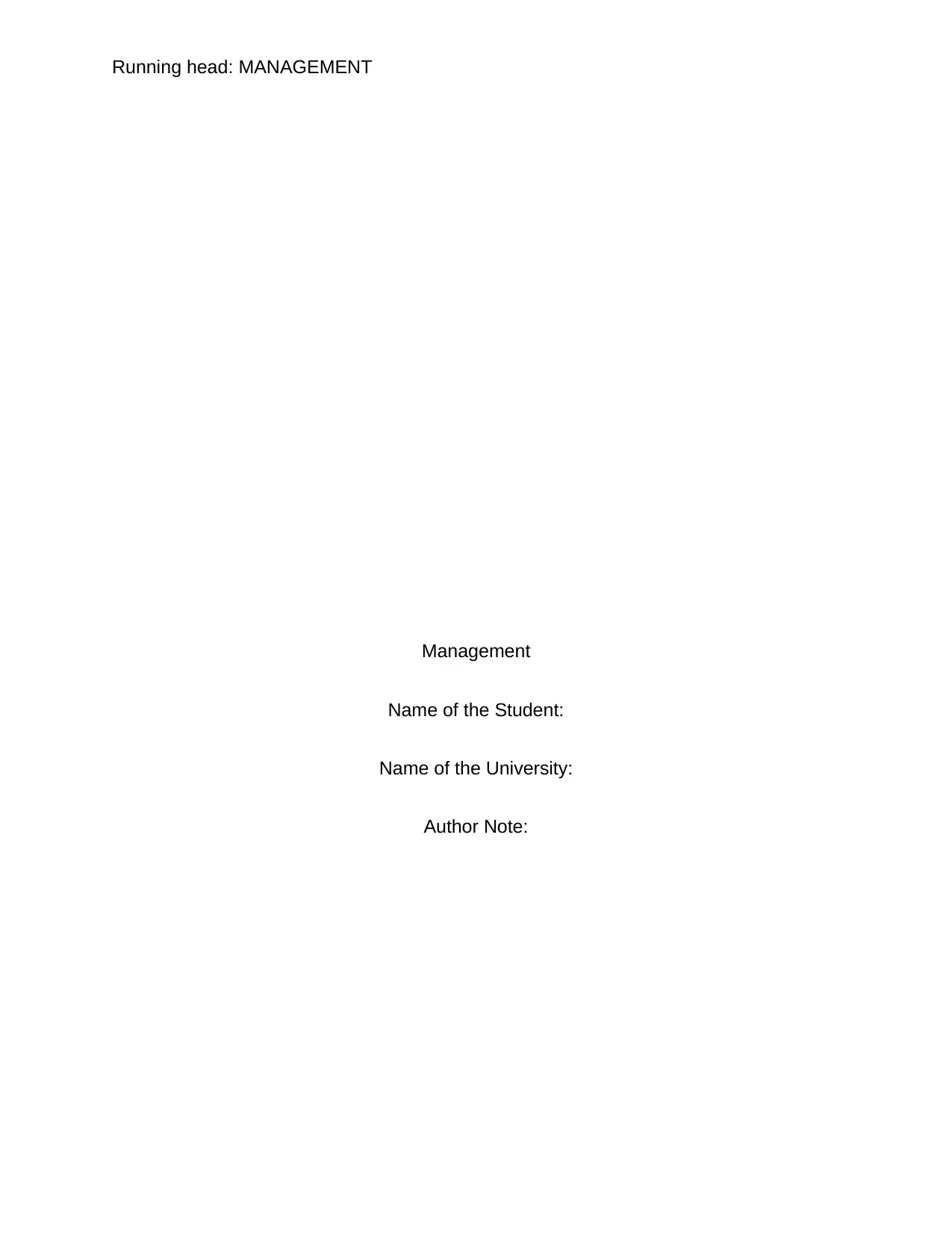
Running head: MANAGEMENT
Management
Name of the Student:
Name of the University:
Author Note:
Management
Name of the Student:
Name of the University:
Author Note:
Paraphrase This Document
Need a fresh take? Get an instant paraphrase of this document with our AI Paraphraser
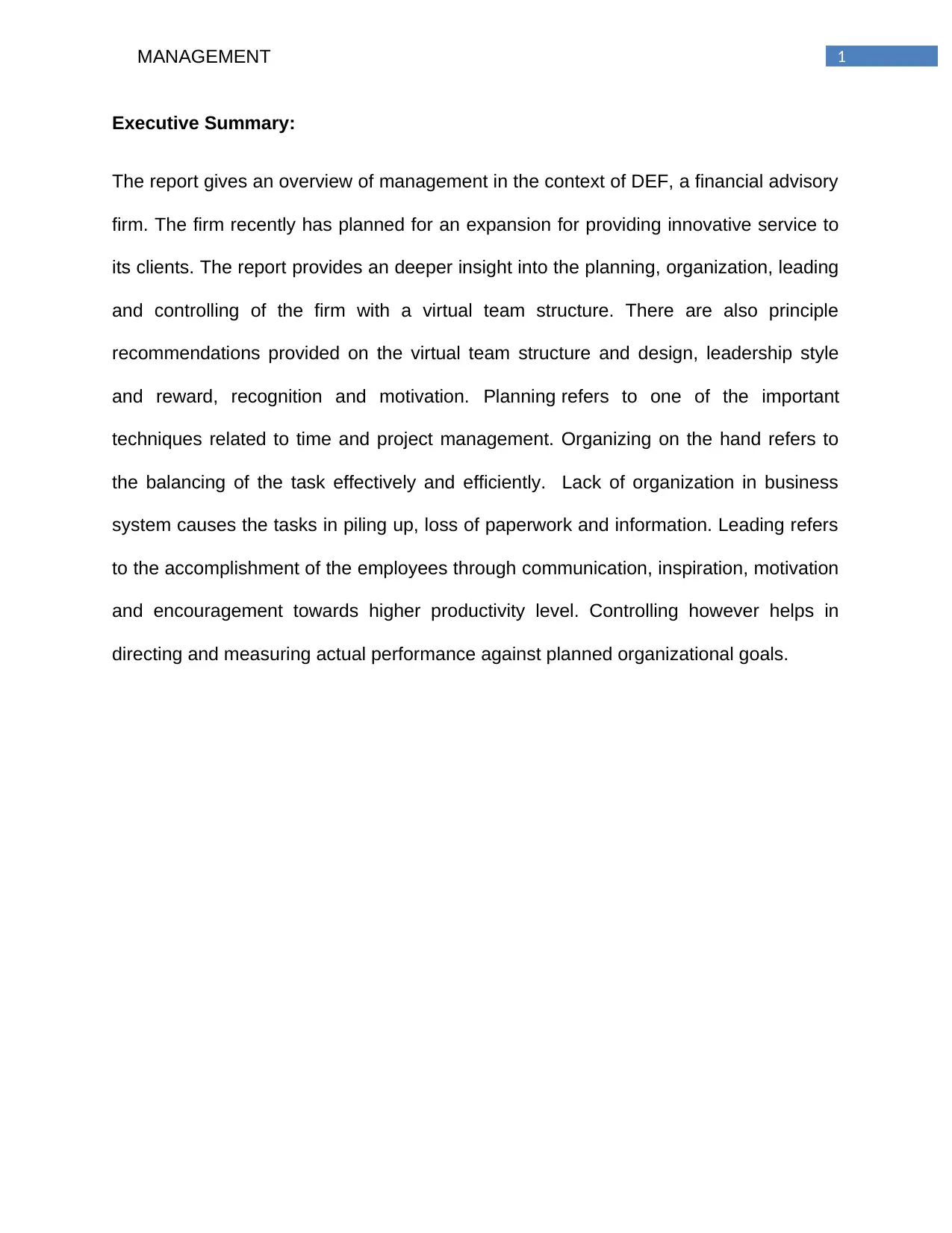
1MANAGEMENT
Executive Summary:
The report gives an overview of management in the context of DEF, a financial advisory
firm. The firm recently has planned for an expansion for providing innovative service to
its clients. The report provides an deeper insight into the planning, organization, leading
and controlling of the firm with a virtual team structure. There are also principle
recommendations provided on the virtual team structure and design, leadership style
and reward, recognition and motivation. Planning refers to one of the important
techniques related to time and project management. Organizing on the hand refers to
the balancing of the task effectively and efficiently. Lack of organization in business
system causes the tasks in piling up, loss of paperwork and information. Leading refers
to the accomplishment of the employees through communication, inspiration, motivation
and encouragement towards higher productivity level. Controlling however helps in
directing and measuring actual performance against planned organizational goals.
Executive Summary:
The report gives an overview of management in the context of DEF, a financial advisory
firm. The firm recently has planned for an expansion for providing innovative service to
its clients. The report provides an deeper insight into the planning, organization, leading
and controlling of the firm with a virtual team structure. There are also principle
recommendations provided on the virtual team structure and design, leadership style
and reward, recognition and motivation. Planning refers to one of the important
techniques related to time and project management. Organizing on the hand refers to
the balancing of the task effectively and efficiently. Lack of organization in business
system causes the tasks in piling up, loss of paperwork and information. Leading refers
to the accomplishment of the employees through communication, inspiration, motivation
and encouragement towards higher productivity level. Controlling however helps in
directing and measuring actual performance against planned organizational goals.
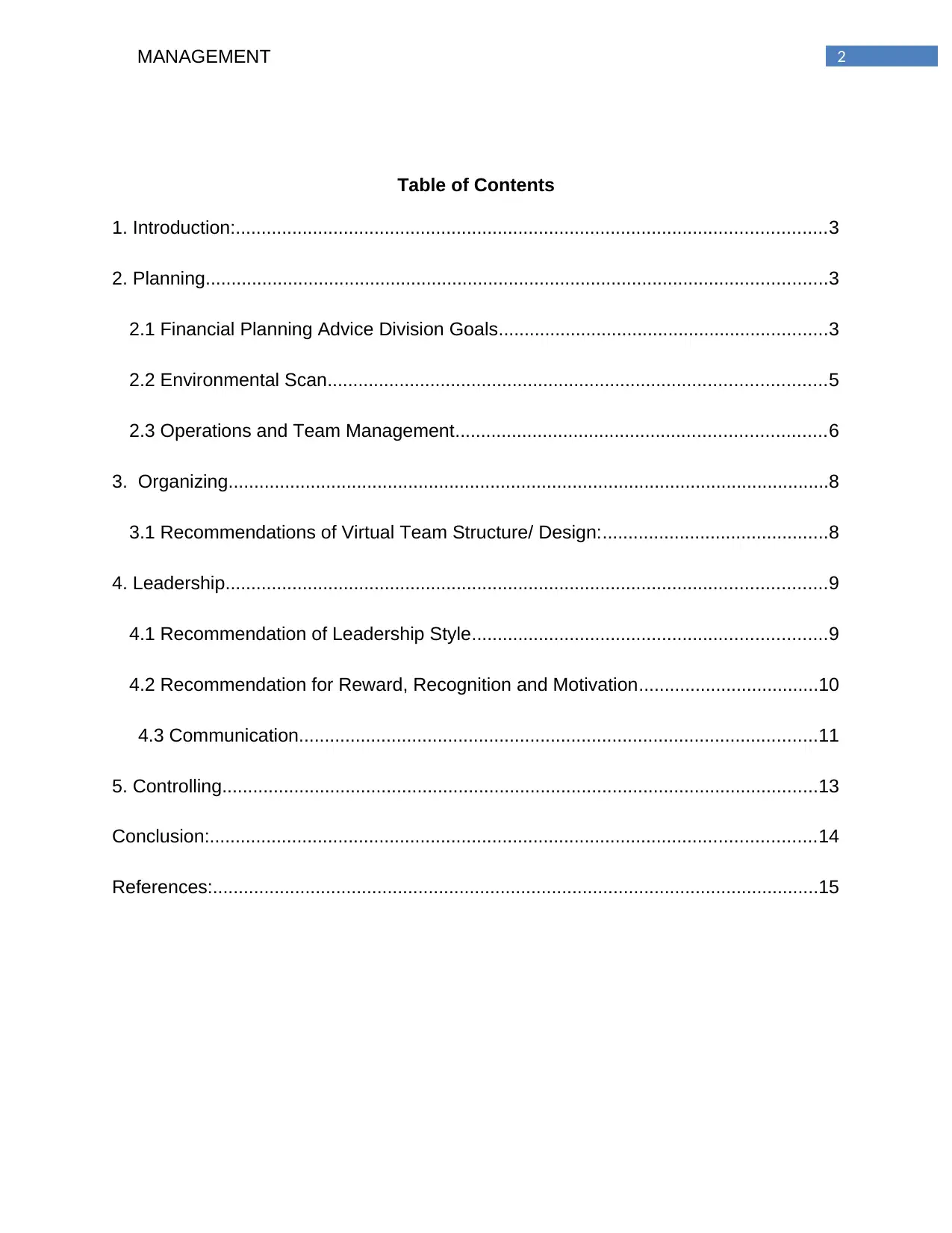
2MANAGEMENT
Table of Contents
1. Introduction:...................................................................................................................3
2. Planning.........................................................................................................................3
2.1 Financial Planning Advice Division Goals................................................................3
2.2 Environmental Scan.................................................................................................5
2.3 Operations and Team Management........................................................................6
3. Organizing.....................................................................................................................8
3.1 Recommendations of Virtual Team Structure/ Design:............................................8
4. Leadership.....................................................................................................................9
4.1 Recommendation of Leadership Style.....................................................................9
4.2 Recommendation for Reward, Recognition and Motivation...................................10
4.3 Communication.....................................................................................................11
5. Controlling....................................................................................................................13
Conclusion:......................................................................................................................14
References:......................................................................................................................15
Table of Contents
1. Introduction:...................................................................................................................3
2. Planning.........................................................................................................................3
2.1 Financial Planning Advice Division Goals................................................................3
2.2 Environmental Scan.................................................................................................5
2.3 Operations and Team Management........................................................................6
3. Organizing.....................................................................................................................8
3.1 Recommendations of Virtual Team Structure/ Design:............................................8
4. Leadership.....................................................................................................................9
4.1 Recommendation of Leadership Style.....................................................................9
4.2 Recommendation for Reward, Recognition and Motivation...................................10
4.3 Communication.....................................................................................................11
5. Controlling....................................................................................................................13
Conclusion:......................................................................................................................14
References:......................................................................................................................15
⊘ This is a preview!⊘
Do you want full access?
Subscribe today to unlock all pages.

Trusted by 1+ million students worldwide
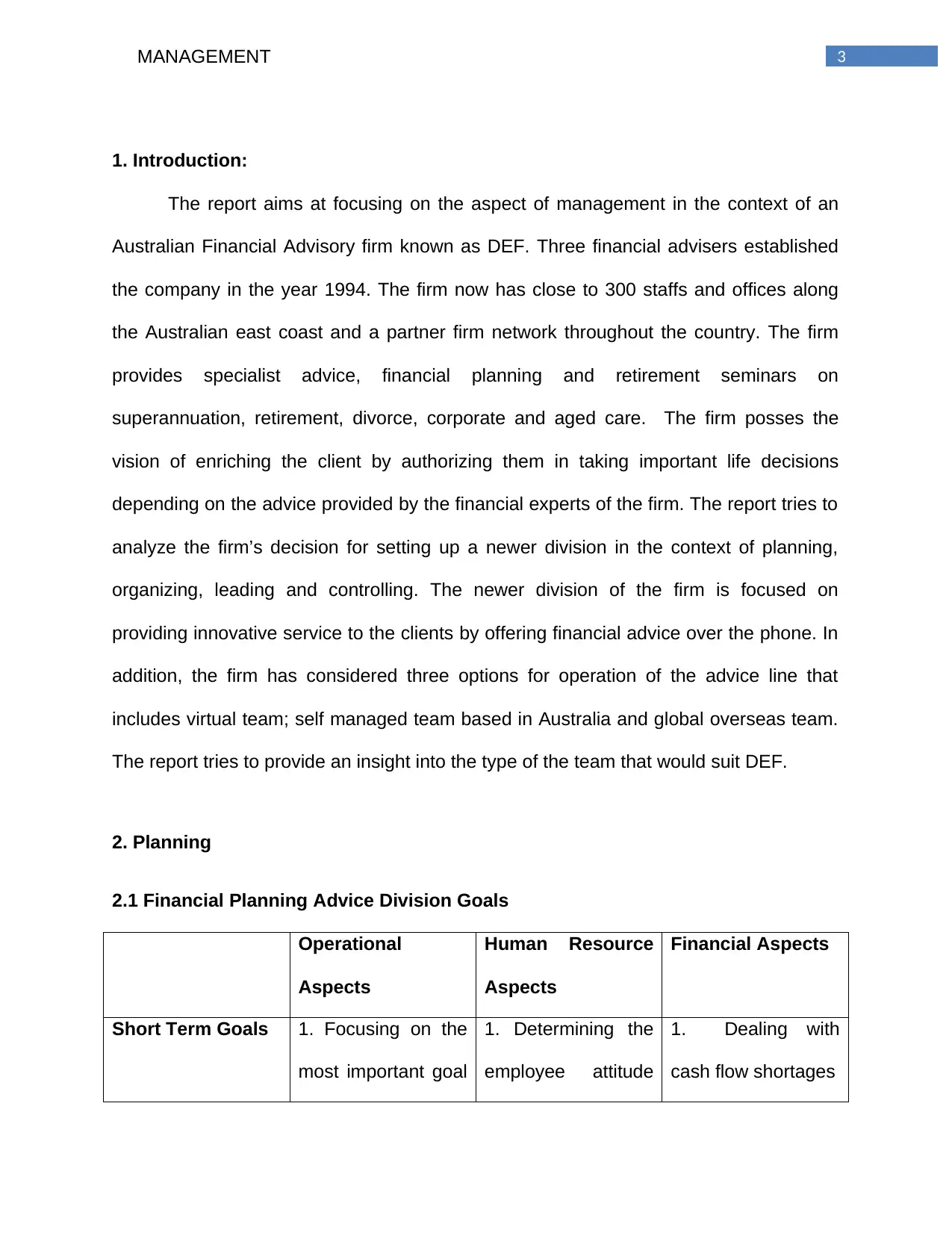
3MANAGEMENT
1. Introduction:
The report aims at focusing on the aspect of management in the context of an
Australian Financial Advisory firm known as DEF. Three financial advisers established
the company in the year 1994. The firm now has close to 300 staffs and offices along
the Australian east coast and a partner firm network throughout the country. The firm
provides specialist advice, financial planning and retirement seminars on
superannuation, retirement, divorce, corporate and aged care. The firm posses the
vision of enriching the client by authorizing them in taking important life decisions
depending on the advice provided by the financial experts of the firm. The report tries to
analyze the firm’s decision for setting up a newer division in the context of planning,
organizing, leading and controlling. The newer division of the firm is focused on
providing innovative service to the clients by offering financial advice over the phone. In
addition, the firm has considered three options for operation of the advice line that
includes virtual team; self managed team based in Australia and global overseas team.
The report tries to provide an insight into the type of the team that would suit DEF.
2. Planning
2.1 Financial Planning Advice Division Goals
Operational
Aspects
Human Resource
Aspects
Financial Aspects
Short Term Goals 1. Focusing on the
most important goal
1. Determining the
employee attitude
1. Dealing with
cash flow shortages
1. Introduction:
The report aims at focusing on the aspect of management in the context of an
Australian Financial Advisory firm known as DEF. Three financial advisers established
the company in the year 1994. The firm now has close to 300 staffs and offices along
the Australian east coast and a partner firm network throughout the country. The firm
provides specialist advice, financial planning and retirement seminars on
superannuation, retirement, divorce, corporate and aged care. The firm posses the
vision of enriching the client by authorizing them in taking important life decisions
depending on the advice provided by the financial experts of the firm. The report tries to
analyze the firm’s decision for setting up a newer division in the context of planning,
organizing, leading and controlling. The newer division of the firm is focused on
providing innovative service to the clients by offering financial advice over the phone. In
addition, the firm has considered three options for operation of the advice line that
includes virtual team; self managed team based in Australia and global overseas team.
The report tries to provide an insight into the type of the team that would suit DEF.
2. Planning
2.1 Financial Planning Advice Division Goals
Operational
Aspects
Human Resource
Aspects
Financial Aspects
Short Term Goals 1. Focusing on the
most important goal
1. Determining the
employee attitude
1. Dealing with
cash flow shortages
Paraphrase This Document
Need a fresh take? Get an instant paraphrase of this document with our AI Paraphraser
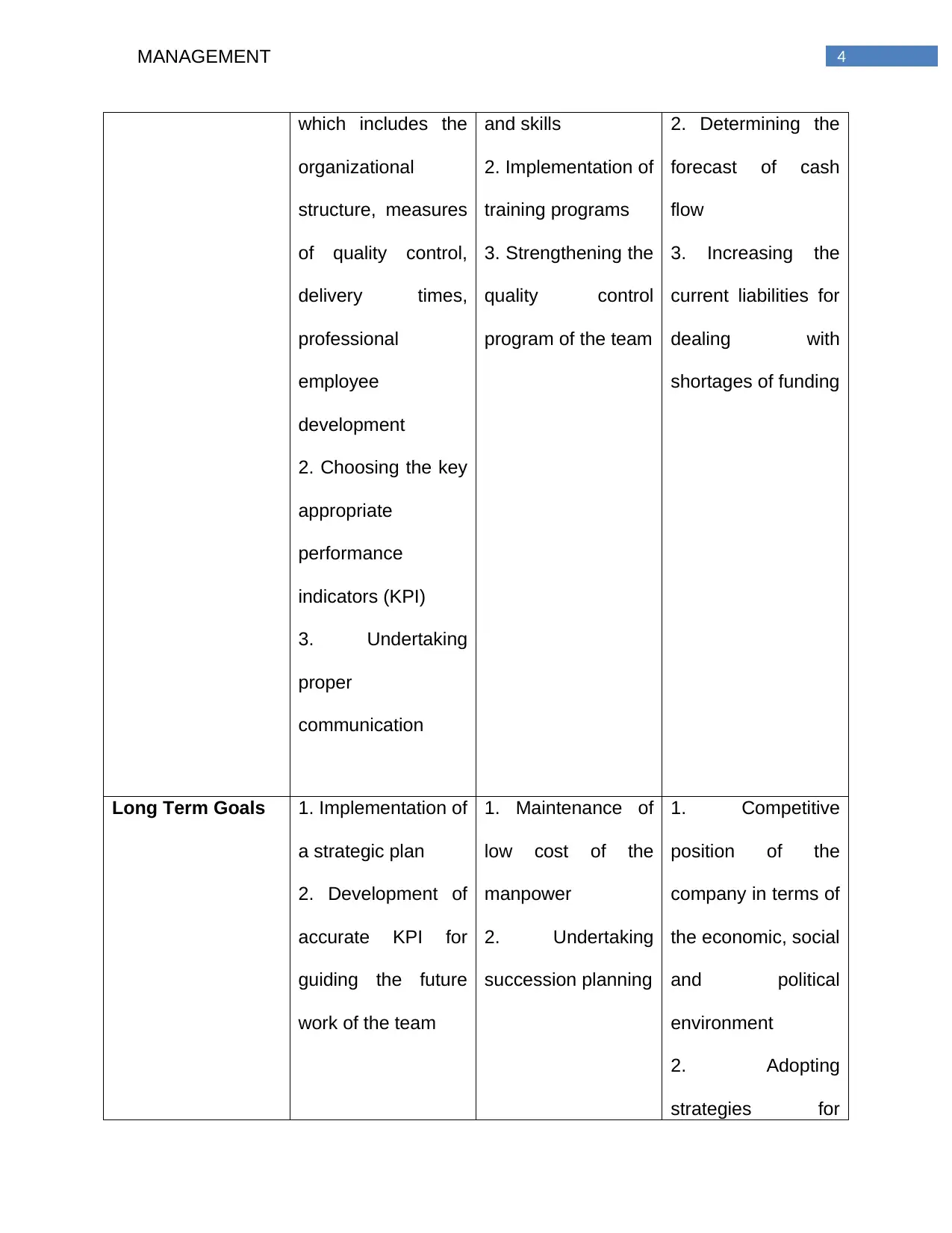
4MANAGEMENT
which includes the
organizational
structure, measures
of quality control,
delivery times,
professional
employee
development
2. Choosing the key
appropriate
performance
indicators (KPI)
3. Undertaking
proper
communication
and skills
2. Implementation of
training programs
3. Strengthening the
quality control
program of the team
2. Determining the
forecast of cash
flow
3. Increasing the
current liabilities for
dealing with
shortages of funding
Long Term Goals 1. Implementation of
a strategic plan
2. Development of
accurate KPI for
guiding the future
work of the team
1. Maintenance of
low cost of the
manpower
2. Undertaking
succession planning
1. Competitive
position of the
company in terms of
the economic, social
and political
environment
2. Adopting
strategies for
which includes the
organizational
structure, measures
of quality control,
delivery times,
professional
employee
development
2. Choosing the key
appropriate
performance
indicators (KPI)
3. Undertaking
proper
communication
and skills
2. Implementation of
training programs
3. Strengthening the
quality control
program of the team
2. Determining the
forecast of cash
flow
3. Increasing the
current liabilities for
dealing with
shortages of funding
Long Term Goals 1. Implementation of
a strategic plan
2. Development of
accurate KPI for
guiding the future
work of the team
1. Maintenance of
low cost of the
manpower
2. Undertaking
succession planning
1. Competitive
position of the
company in terms of
the economic, social
and political
environment
2. Adopting
strategies for
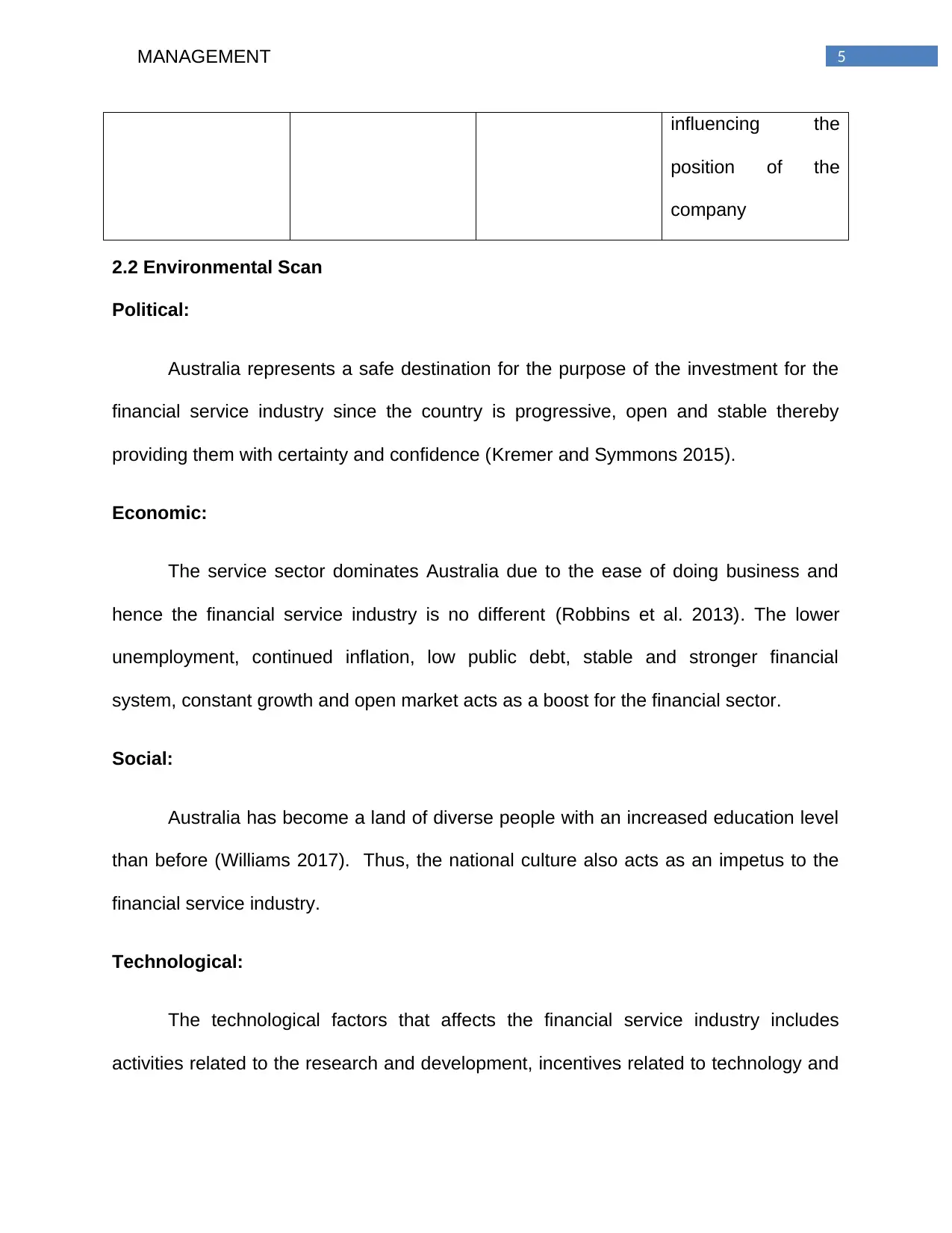
5MANAGEMENT
influencing the
position of the
company
2.2 Environmental Scan
Political:
Australia represents a safe destination for the purpose of the investment for the
financial service industry since the country is progressive, open and stable thereby
providing them with certainty and confidence (Kremer and Symmons 2015).
Economic:
The service sector dominates Australia due to the ease of doing business and
hence the financial service industry is no different (Robbins et al. 2013). The lower
unemployment, continued inflation, low public debt, stable and stronger financial
system, constant growth and open market acts as a boost for the financial sector.
Social:
Australia has become a land of diverse people with an increased education level
than before (Williams 2017). Thus, the national culture also acts as an impetus to the
financial service industry.
Technological:
The technological factors that affects the financial service industry includes
activities related to the research and development, incentives related to technology and
influencing the
position of the
company
2.2 Environmental Scan
Political:
Australia represents a safe destination for the purpose of the investment for the
financial service industry since the country is progressive, open and stable thereby
providing them with certainty and confidence (Kremer and Symmons 2015).
Economic:
The service sector dominates Australia due to the ease of doing business and
hence the financial service industry is no different (Robbins et al. 2013). The lower
unemployment, continued inflation, low public debt, stable and stronger financial
system, constant growth and open market acts as a boost for the financial sector.
Social:
Australia has become a land of diverse people with an increased education level
than before (Williams 2017). Thus, the national culture also acts as an impetus to the
financial service industry.
Technological:
The technological factors that affects the financial service industry includes
activities related to the research and development, incentives related to technology and
⊘ This is a preview!⊘
Do you want full access?
Subscribe today to unlock all pages.

Trusted by 1+ million students worldwide
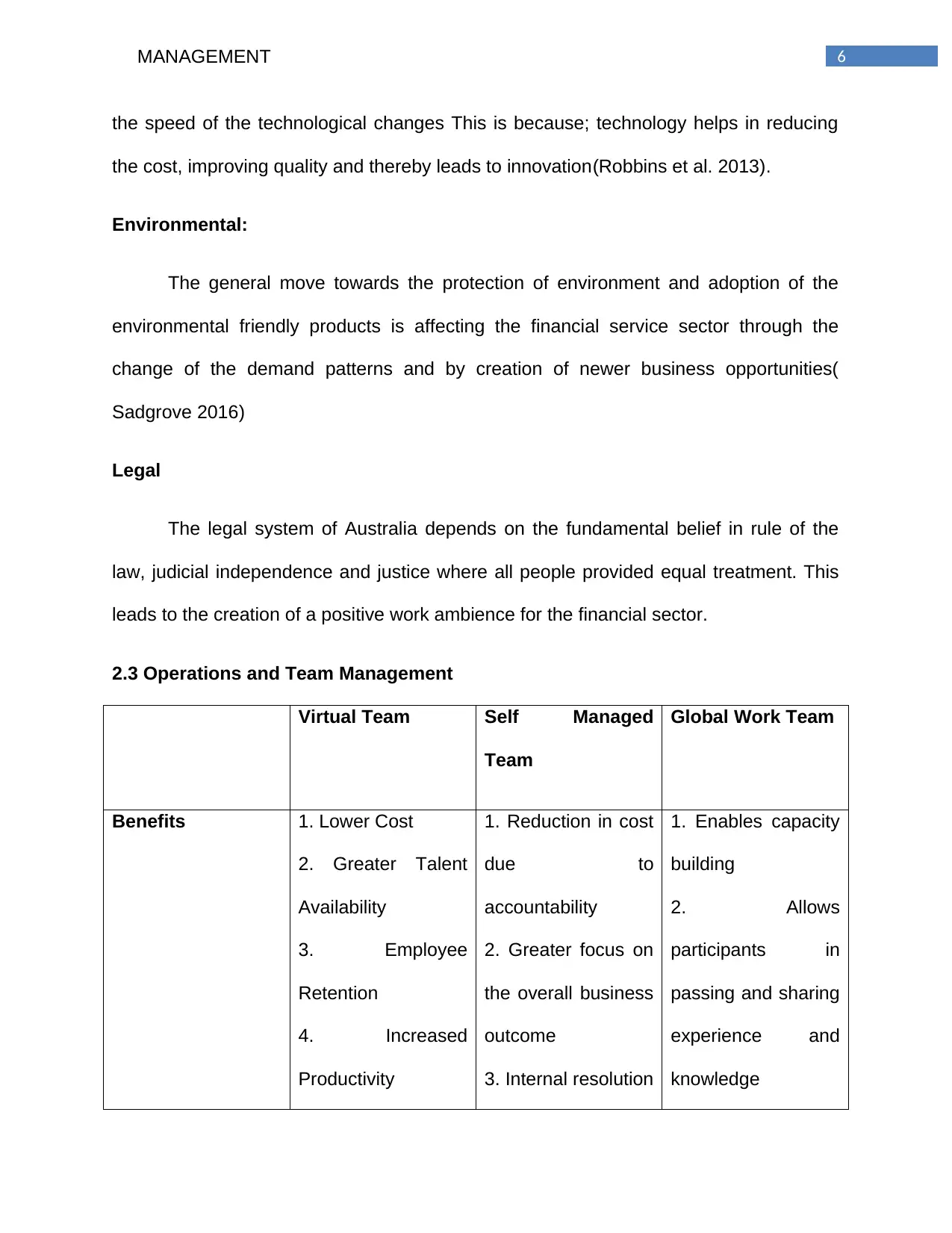
6MANAGEMENT
the speed of the technological changes This is because; technology helps in reducing
the cost, improving quality and thereby leads to innovation(Robbins et al. 2013).
Environmental:
The general move towards the protection of environment and adoption of the
environmental friendly products is affecting the financial service sector through the
change of the demand patterns and by creation of newer business opportunities(
Sadgrove 2016)
Legal
The legal system of Australia depends on the fundamental belief in rule of the
law, judicial independence and justice where all people provided equal treatment. This
leads to the creation of a positive work ambience for the financial sector.
2.3 Operations and Team Management
Virtual Team Self Managed
Team
Global Work Team
Benefits 1. Lower Cost
2. Greater Talent
Availability
3. Employee
Retention
4. Increased
Productivity
1. Reduction in cost
due to
accountability
2. Greater focus on
the overall business
outcome
3. Internal resolution
1. Enables capacity
building
2. Allows
participants in
passing and sharing
experience and
knowledge
the speed of the technological changes This is because; technology helps in reducing
the cost, improving quality and thereby leads to innovation(Robbins et al. 2013).
Environmental:
The general move towards the protection of environment and adoption of the
environmental friendly products is affecting the financial service sector through the
change of the demand patterns and by creation of newer business opportunities(
Sadgrove 2016)
Legal
The legal system of Australia depends on the fundamental belief in rule of the
law, judicial independence and justice where all people provided equal treatment. This
leads to the creation of a positive work ambience for the financial sector.
2.3 Operations and Team Management
Virtual Team Self Managed
Team
Global Work Team
Benefits 1. Lower Cost
2. Greater Talent
Availability
3. Employee
Retention
4. Increased
Productivity
1. Reduction in cost
due to
accountability
2. Greater focus on
the overall business
outcome
3. Internal resolution
1. Enables capacity
building
2. Allows
participants in
passing and sharing
experience and
knowledge
Paraphrase This Document
Need a fresh take? Get an instant paraphrase of this document with our AI Paraphraser
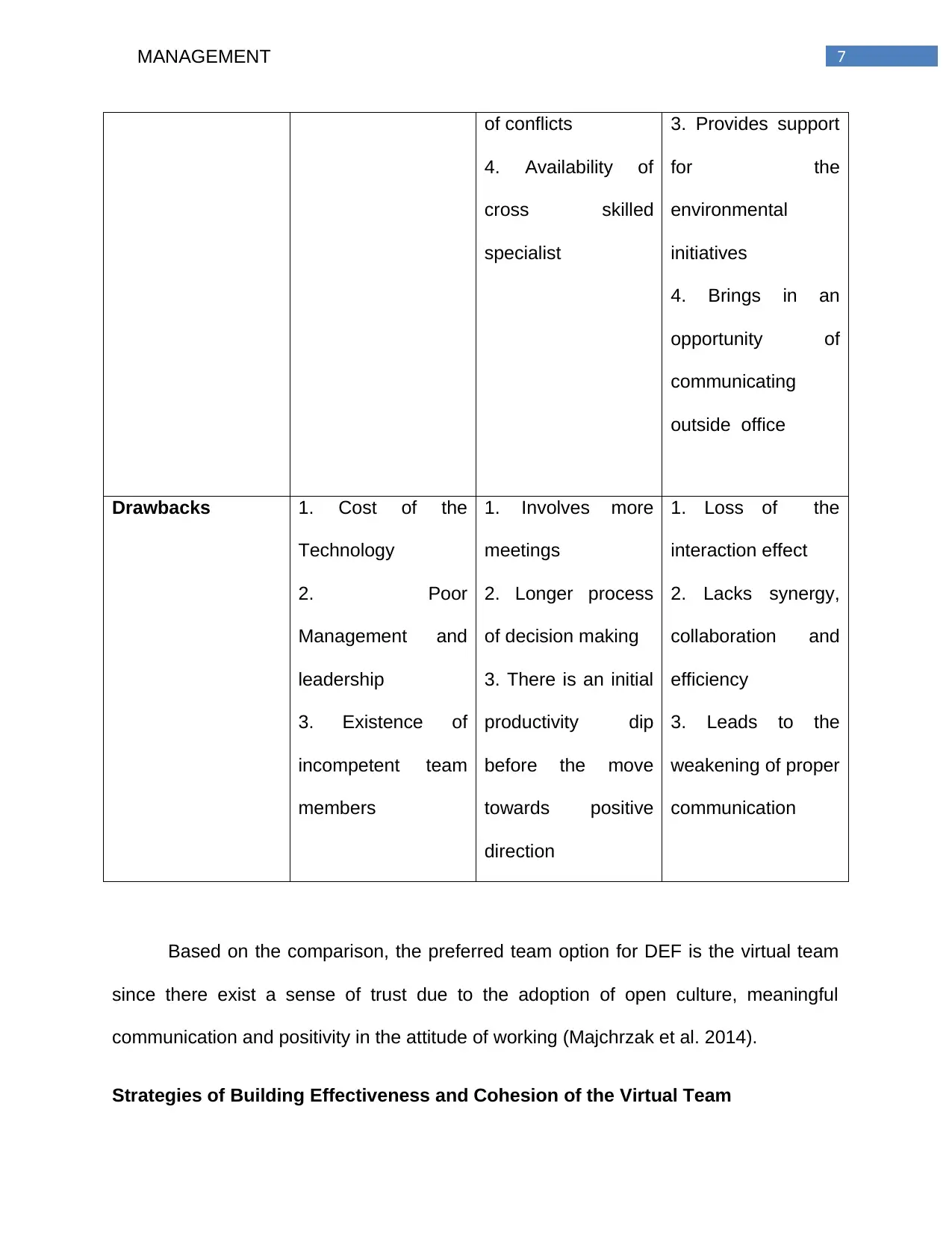
7MANAGEMENT
of conflicts
4. Availability of
cross skilled
specialist
3. Provides support
for the
environmental
initiatives
4. Brings in an
opportunity of
communicating
outside office
Drawbacks 1. Cost of the
Technology
2. Poor
Management and
leadership
3. Existence of
incompetent team
members
1. Involves more
meetings
2. Longer process
of decision making
3. There is an initial
productivity dip
before the move
towards positive
direction
1. Loss of the
interaction effect
2. Lacks synergy,
collaboration and
efficiency
3. Leads to the
weakening of proper
communication
Based on the comparison, the preferred team option for DEF is the virtual team
since there exist a sense of trust due to the adoption of open culture, meaningful
communication and positivity in the attitude of working (Majchrzak et al. 2014).
Strategies of Building Effectiveness and Cohesion of the Virtual Team
of conflicts
4. Availability of
cross skilled
specialist
3. Provides support
for the
environmental
initiatives
4. Brings in an
opportunity of
communicating
outside office
Drawbacks 1. Cost of the
Technology
2. Poor
Management and
leadership
3. Existence of
incompetent team
members
1. Involves more
meetings
2. Longer process
of decision making
3. There is an initial
productivity dip
before the move
towards positive
direction
1. Loss of the
interaction effect
2. Lacks synergy,
collaboration and
efficiency
3. Leads to the
weakening of proper
communication
Based on the comparison, the preferred team option for DEF is the virtual team
since there exist a sense of trust due to the adoption of open culture, meaningful
communication and positivity in the attitude of working (Majchrzak et al. 2014).
Strategies of Building Effectiveness and Cohesion of the Virtual Team
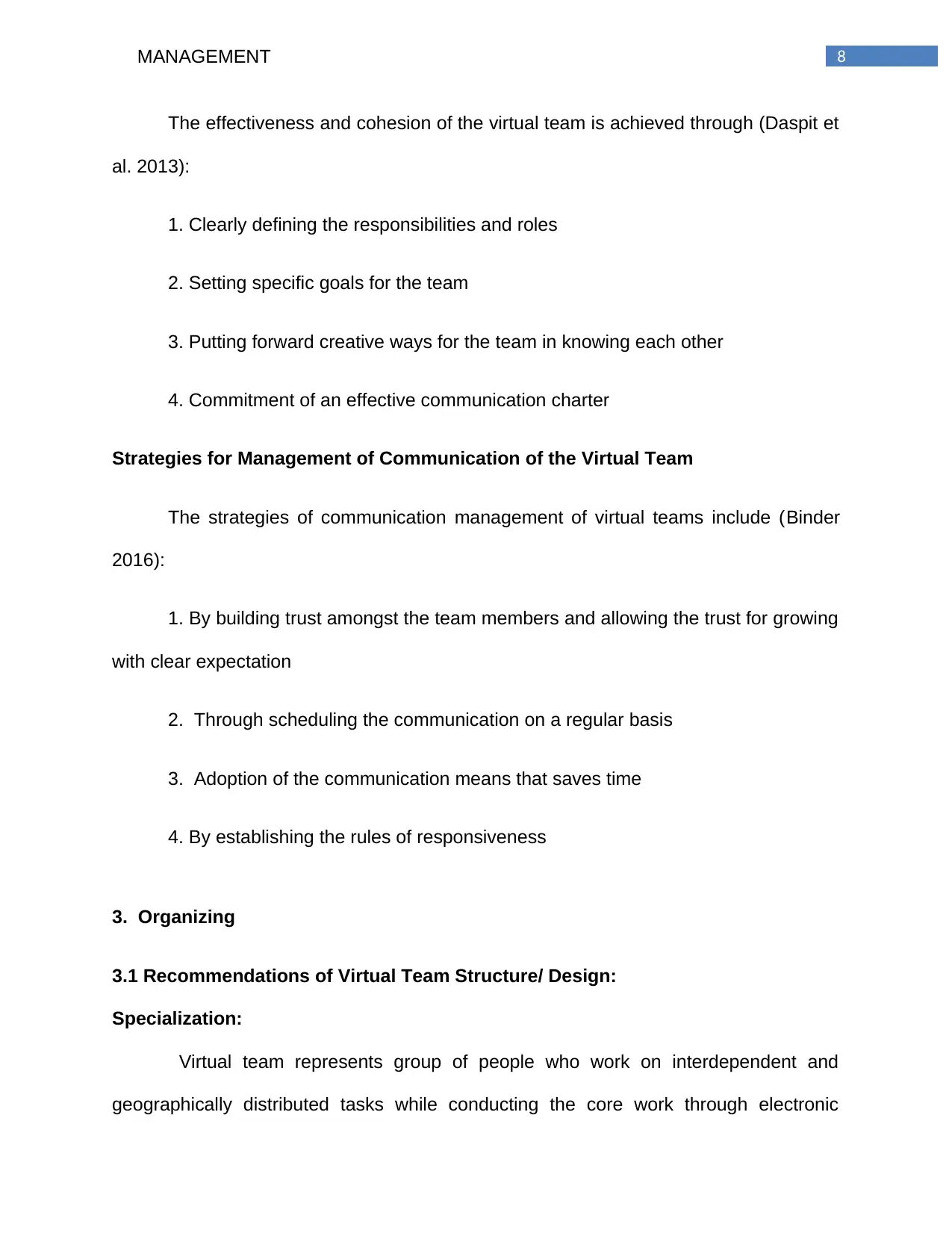
8MANAGEMENT
The effectiveness and cohesion of the virtual team is achieved through (Daspit et
al. 2013):
1. Clearly defining the responsibilities and roles
2. Setting specific goals for the team
3. Putting forward creative ways for the team in knowing each other
4. Commitment of an effective communication charter
Strategies for Management of Communication of the Virtual Team
The strategies of communication management of virtual teams include (Binder
2016):
1. By building trust amongst the team members and allowing the trust for growing
with clear expectation
2. Through scheduling the communication on a regular basis
3. Adoption of the communication means that saves time
4. By establishing the rules of responsiveness
3. Organizing
3.1 Recommendations of Virtual Team Structure/ Design:
Specialization:
Virtual team represents group of people who work on interdependent and
geographically distributed tasks while conducting the core work through electronic
The effectiveness and cohesion of the virtual team is achieved through (Daspit et
al. 2013):
1. Clearly defining the responsibilities and roles
2. Setting specific goals for the team
3. Putting forward creative ways for the team in knowing each other
4. Commitment of an effective communication charter
Strategies for Management of Communication of the Virtual Team
The strategies of communication management of virtual teams include (Binder
2016):
1. By building trust amongst the team members and allowing the trust for growing
with clear expectation
2. Through scheduling the communication on a regular basis
3. Adoption of the communication means that saves time
4. By establishing the rules of responsiveness
3. Organizing
3.1 Recommendations of Virtual Team Structure/ Design:
Specialization:
Virtual team represents group of people who work on interdependent and
geographically distributed tasks while conducting the core work through electronic
⊘ This is a preview!⊘
Do you want full access?
Subscribe today to unlock all pages.

Trusted by 1+ million students worldwide
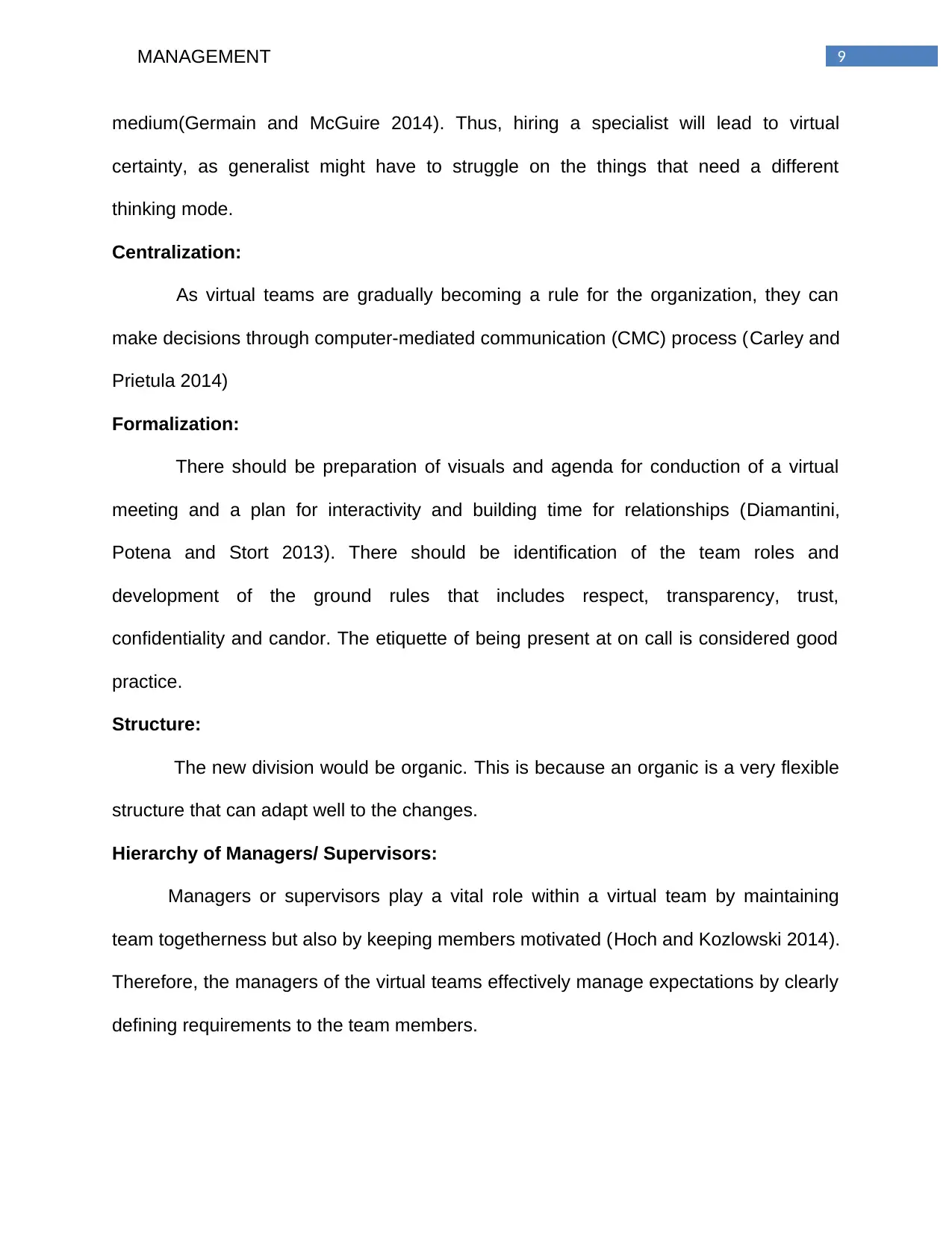
9MANAGEMENT
medium(Germain and McGuire 2014). Thus, hiring a specialist will lead to virtual
certainty, as generalist might have to struggle on the things that need a different
thinking mode.
Centralization:
As virtual teams are gradually becoming a rule for the organization, they can
make decisions through computer-mediated communication (CMC) process (Carley and
Prietula 2014)
Formalization:
There should be preparation of visuals and agenda for conduction of a virtual
meeting and a plan for interactivity and building time for relationships (Diamantini,
Potena and Stort 2013). There should be identification of the team roles and
development of the ground rules that includes respect, transparency, trust,
confidentiality and candor. The etiquette of being present at on call is considered good
practice.
Structure:
The new division would be organic. This is because an organic is a very flexible
structure that can adapt well to the changes.
Hierarchy of Managers/ Supervisors:
Managers or supervisors play a vital role within a virtual team by maintaining
team togetherness but also by keeping members motivated (Hoch and Kozlowski 2014).
Therefore, the managers of the virtual teams effectively manage expectations by clearly
defining requirements to the team members.
medium(Germain and McGuire 2014). Thus, hiring a specialist will lead to virtual
certainty, as generalist might have to struggle on the things that need a different
thinking mode.
Centralization:
As virtual teams are gradually becoming a rule for the organization, they can
make decisions through computer-mediated communication (CMC) process (Carley and
Prietula 2014)
Formalization:
There should be preparation of visuals and agenda for conduction of a virtual
meeting and a plan for interactivity and building time for relationships (Diamantini,
Potena and Stort 2013). There should be identification of the team roles and
development of the ground rules that includes respect, transparency, trust,
confidentiality and candor. The etiquette of being present at on call is considered good
practice.
Structure:
The new division would be organic. This is because an organic is a very flexible
structure that can adapt well to the changes.
Hierarchy of Managers/ Supervisors:
Managers or supervisors play a vital role within a virtual team by maintaining
team togetherness but also by keeping members motivated (Hoch and Kozlowski 2014).
Therefore, the managers of the virtual teams effectively manage expectations by clearly
defining requirements to the team members.
Paraphrase This Document
Need a fresh take? Get an instant paraphrase of this document with our AI Paraphraser
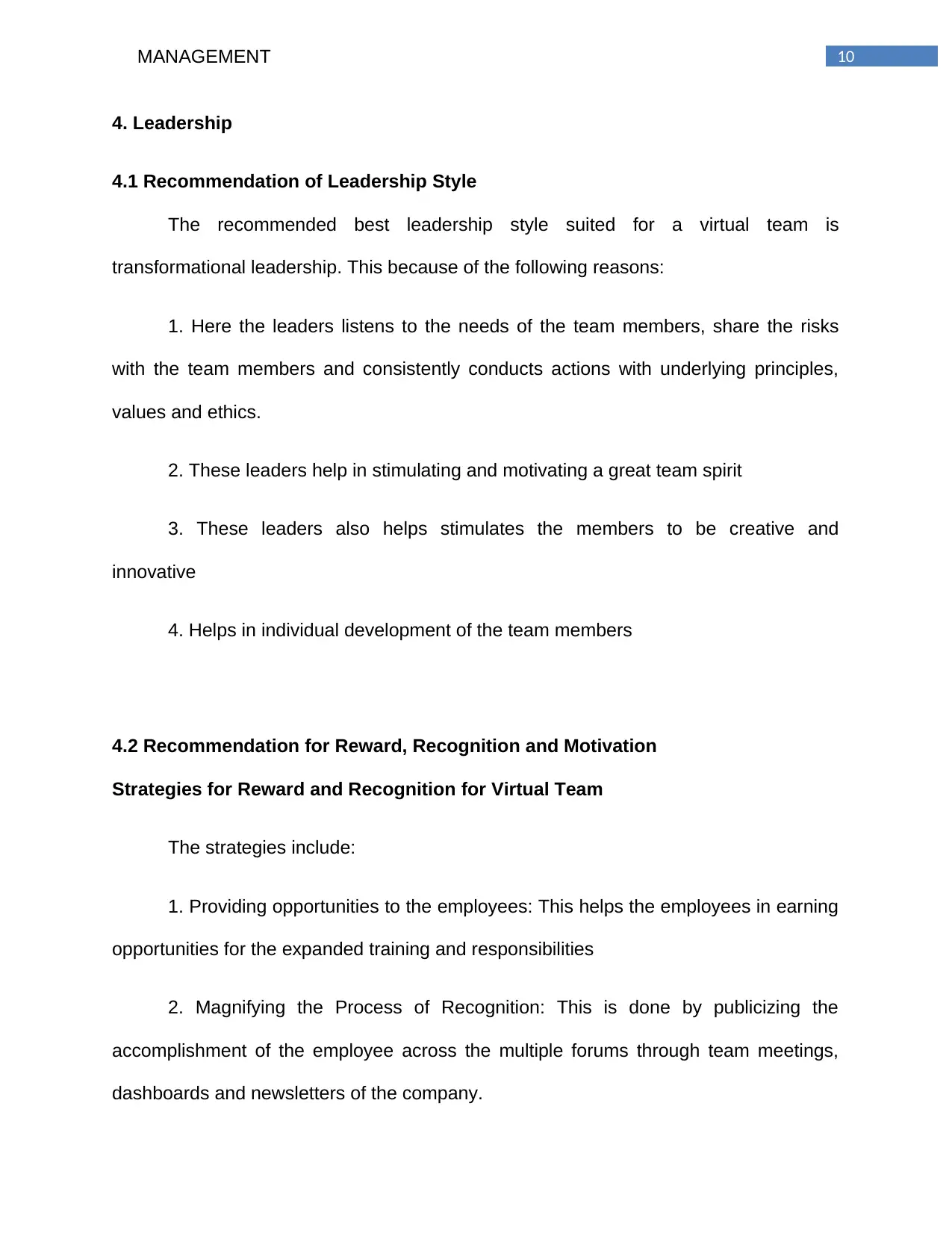
10MANAGEMENT
4. Leadership
4.1 Recommendation of Leadership Style
The recommended best leadership style suited for a virtual team is
transformational leadership. This because of the following reasons:
1. Here the leaders listens to the needs of the team members, share the risks
with the team members and consistently conducts actions with underlying principles,
values and ethics.
2. These leaders help in stimulating and motivating a great team spirit
3. These leaders also helps stimulates the members to be creative and
innovative
4. Helps in individual development of the team members
4.2 Recommendation for Reward, Recognition and Motivation
Strategies for Reward and Recognition for Virtual Team
The strategies include:
1. Providing opportunities to the employees: This helps the employees in earning
opportunities for the expanded training and responsibilities
2. Magnifying the Process of Recognition: This is done by publicizing the
accomplishment of the employee across the multiple forums through team meetings,
dashboards and newsletters of the company.
4. Leadership
4.1 Recommendation of Leadership Style
The recommended best leadership style suited for a virtual team is
transformational leadership. This because of the following reasons:
1. Here the leaders listens to the needs of the team members, share the risks
with the team members and consistently conducts actions with underlying principles,
values and ethics.
2. These leaders help in stimulating and motivating a great team spirit
3. These leaders also helps stimulates the members to be creative and
innovative
4. Helps in individual development of the team members
4.2 Recommendation for Reward, Recognition and Motivation
Strategies for Reward and Recognition for Virtual Team
The strategies include:
1. Providing opportunities to the employees: This helps the employees in earning
opportunities for the expanded training and responsibilities
2. Magnifying the Process of Recognition: This is done by publicizing the
accomplishment of the employee across the multiple forums through team meetings,
dashboards and newsletters of the company.
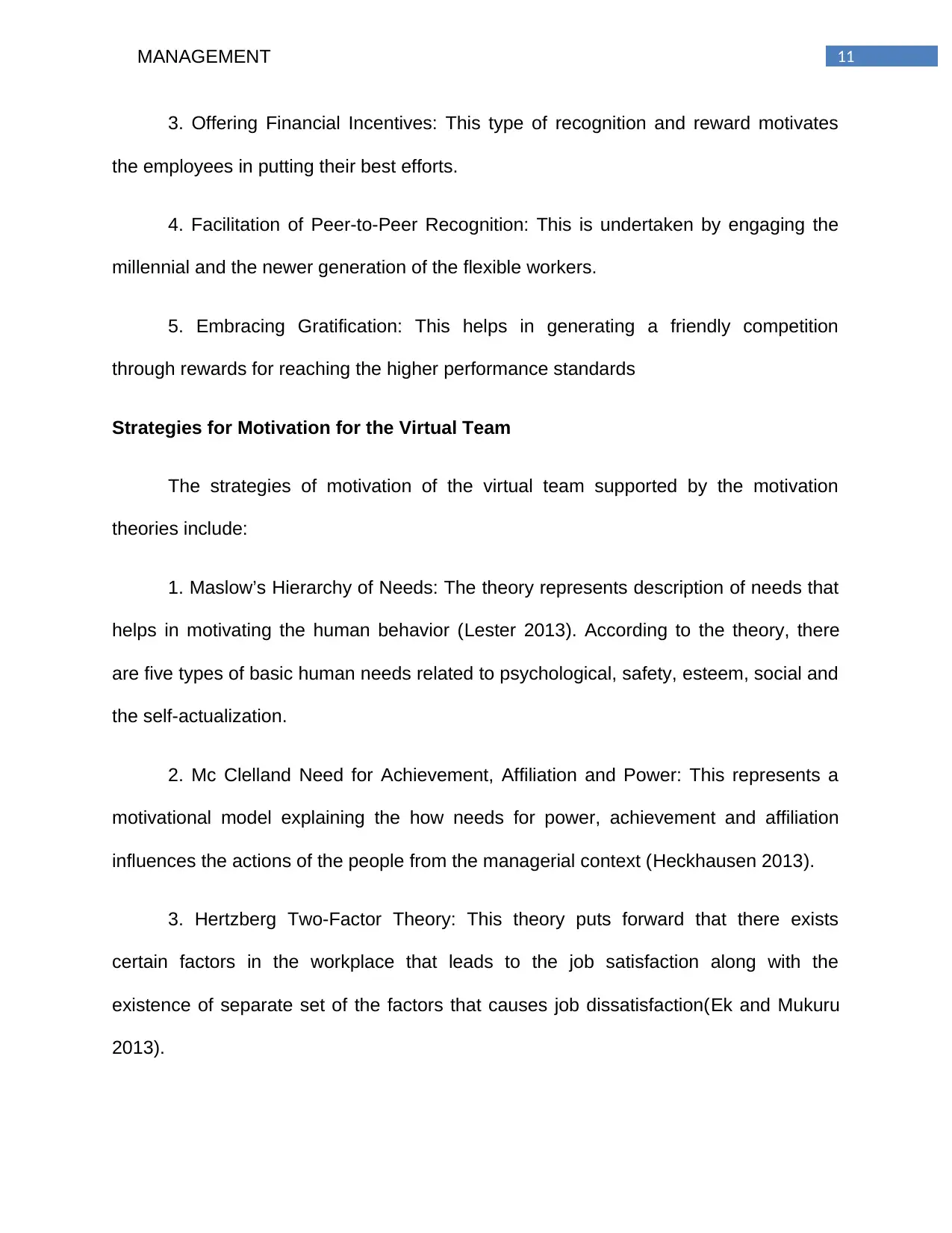
11MANAGEMENT
3. Offering Financial Incentives: This type of recognition and reward motivates
the employees in putting their best efforts.
4. Facilitation of Peer-to-Peer Recognition: This is undertaken by engaging the
millennial and the newer generation of the flexible workers.
5. Embracing Gratification: This helps in generating a friendly competition
through rewards for reaching the higher performance standards
Strategies for Motivation for the Virtual Team
The strategies of motivation of the virtual team supported by the motivation
theories include:
1. Maslow’s Hierarchy of Needs: The theory represents description of needs that
helps in motivating the human behavior (Lester 2013). According to the theory, there
are five types of basic human needs related to psychological, safety, esteem, social and
the self-actualization.
2. Mc Clelland Need for Achievement, Affiliation and Power: This represents a
motivational model explaining the how needs for power, achievement and affiliation
influences the actions of the people from the managerial context (Heckhausen 2013).
3. Hertzberg Two-Factor Theory: This theory puts forward that there exists
certain factors in the workplace that leads to the job satisfaction along with the
existence of separate set of the factors that causes job dissatisfaction(Ek and Mukuru
2013).
3. Offering Financial Incentives: This type of recognition and reward motivates
the employees in putting their best efforts.
4. Facilitation of Peer-to-Peer Recognition: This is undertaken by engaging the
millennial and the newer generation of the flexible workers.
5. Embracing Gratification: This helps in generating a friendly competition
through rewards for reaching the higher performance standards
Strategies for Motivation for the Virtual Team
The strategies of motivation of the virtual team supported by the motivation
theories include:
1. Maslow’s Hierarchy of Needs: The theory represents description of needs that
helps in motivating the human behavior (Lester 2013). According to the theory, there
are five types of basic human needs related to psychological, safety, esteem, social and
the self-actualization.
2. Mc Clelland Need for Achievement, Affiliation and Power: This represents a
motivational model explaining the how needs for power, achievement and affiliation
influences the actions of the people from the managerial context (Heckhausen 2013).
3. Hertzberg Two-Factor Theory: This theory puts forward that there exists
certain factors in the workplace that leads to the job satisfaction along with the
existence of separate set of the factors that causes job dissatisfaction(Ek and Mukuru
2013).
⊘ This is a preview!⊘
Do you want full access?
Subscribe today to unlock all pages.

Trusted by 1+ million students worldwide
1 out of 17
Related Documents
Your All-in-One AI-Powered Toolkit for Academic Success.
+13062052269
info@desklib.com
Available 24*7 on WhatsApp / Email
![[object Object]](/_next/static/media/star-bottom.7253800d.svg)
Unlock your academic potential
Copyright © 2020–2025 A2Z Services. All Rights Reserved. Developed and managed by ZUCOL.




